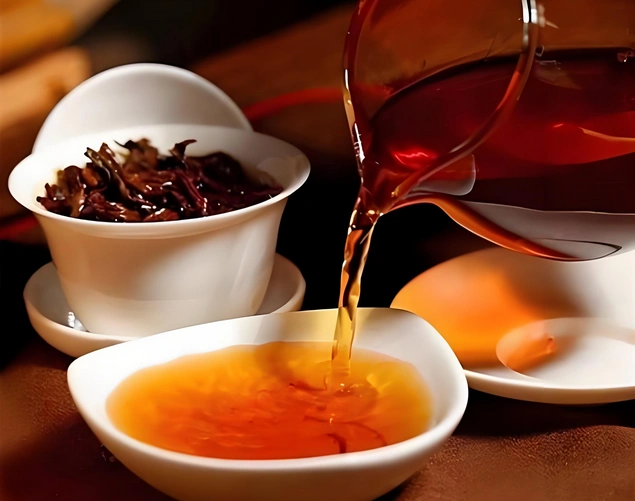Pu erh tea and heart health go hand in hand, inviting you to a centuries-old ritual that soothes the soul and supports the cardiovascular system. Imagine pouring deep amber liquor into a porcelain cup—the aroma of damp forest floor and sweet wood drifting upward. With each sip, the earthy warmth calms your senses and, as research suggests, begins to work on your cholesterol and circulation.
From pu erh tea for cholesterol management to its role in pu erh tea for detoxification and pu erh tea for gut health, this guide walks you through how to brew, when to sip, and the science behind why pu erh is more than just a beverage—it’s a natural ally for your heart.
1. What Is Pu Erh Tea?
Pu erh tea hails from Yunnan Province, China, and comes in two main styles:
- Raw Pu Erh (Sheng): Greenish leaves are pressed into cakes, then naturally age. Fresh sheng tastes grassy and brisk, mellowing into honeyed sweetness over years.
- Ripe Pu Erh (Shou): Undergoes “wet piling” fermentation, producing dark, earthy tea ready to drink within months.
Both types can be stored for decades—each yielding unique flavor layers and evolving health properties. Understanding these distinctions helps you choose the right pu erh tea and heart health partner.

2. Heart Health Basics: Cholesterol & Cardiovascular Risk
Your heart health hinges on balanced lipids and clear arteries. High LDL (“bad”) cholesterol and inflammation increase risk of atherosclerosis and heart disease. Lifestyle factors—diet, exercise, and antioxidants—play vital roles in maintaining healthy cholesterol levels and protecting blood vessels.
3. Pu Erh Tea for Cholesterol Management
One of pu erh tea and heart health’s most celebrated benefits is its ability to improve lipid profiles. In a randomized controlled trial, daily consumption of pu erh tea lowered LDL cholesterol by an average of 10% over eight weeks, while boosting HDL (“good”) cholesterol slightly . Researchers attribute this to pu erh’s unique polyphenols and theabrownins that inhibit cholesterol synthesis in the liver【1】.
- How It Works:
- Theabrownins bind bile acids, prompting the body to convert more cholesterol into new bile, thereby reducing serum levels.
- Catechins and other antioxidants protect LDL from oxidation, a key step in plaque formation.
Including a cup of pu erh in your morning or mid-afternoon routine can thus support healthy cholesterol levels and overall cardiovascular wellness.
4. Detox & Gut Health: Supporting Cardiovascular Wellness
The heart doesn’t work in isolation. Pu erh tea for detoxification and pu erh tea for gut health contribute to systemic balance:
- Detoxification: Pu erh stimulates bile flow and supports liver function, helping clear toxins that burden the heart.
- Gut Microbiome: Preliminary studies show pu erh’s polyphenols promote beneficial gut bacteria, which in turn reduce inflammation and improve nutrient absorption—factors linked to heart health.
By fostering a healthy gut-liver axis, pu erh lays the groundwork for a stronger, more resilient cardiovascular system.

5. Antioxidants & Polyphenols: Mechanisms of Action
Pu erh tea’s health magic stems from its rich antioxidant profile:
- Polyphenols: EGCG, theaflavins, and thearubigins scavenge free radicals, protecting endothelial cells lining blood vessels.
- Theabrownins: Unique to pu erh, these large molecules modulate lipid metabolism and serve as powerful antioxidants.
A meta‑analysis found that regular pu erh intake significantly raised total antioxidant capacity in blood, correlating with improved vascular function and reduced oxidative stress【2】 .
6. Evidence from Research
Beyond lipid studies, clinical trials reveal:
- Blood Pressure Modulation: Habitual pu erh drinkers exhibit modest reductions in both systolic and diastolic pressure, likely via improved endothelial nitric oxide production.
- Inflammation Markers: C‑reactive protein (CRP) levels—an inflammation indicator—decrease in individuals consuming pu erh daily for 12 weeks.
These findings underscore pu erh tea and heart health as a synergistic relationship backed by growing scientific evidence.
7. Brewing & Dosage for Heart Benefits
To maximize benefits:
- Water Temperature: 212 °F (100 °C) for ripe, 195 °F (90 °C) for raw.
- Leaf Ratio: 5 g per 100 ml of water.
- Rinse: Quick 5 s wash to prime leaves.
- Steeping:
- First Infusion: 10–15 s
- Subsequent: +5 s per infusion, up to 8–10 brews
Dosage: 2–3 cups daily, spaced throughout the day. Avoid late-evening cups to prevent caffeine-related sleep disruption. Consistency is key for pu erh tea benefits on cholesterol and detoxification.

8. Precautions & Interactions
While generally safe, note:
- Caffeine Sensitivity: Pu erh contains 30–70 mg caffeine per cup—monitor intake if prone to jitteriness or insomnia.
- Medication Interactions: If you’re on cholesterol‑lowering drugs or blood thinners, consult your physician before adding pu erh to your regimen.
- Tannins & Iron Absorption: Drink between meals to minimize potential inhibition of non-heme iron uptake.
Mindful consumption ensures pu erh tea and heart health remain harmonious.
Conclusion & Next Steps
Embracing pu erh tea and heart health means weaving a centuries‑old brew into your daily routine—relishing earthy warmth while your body reaps cholesterol‑lowering, detoxifying, and antioxidant dividends. Start by sourcing quality raw or ripe pu erh from trusted vendors, brew mindfully, and sip consistently. Watch as your body responds with better lipid profiles, clearer circulation, and uplifted vitality. Share your pu erh journey and heart health wins, and let every cup mark a step toward a stronger, more vibrant you.



